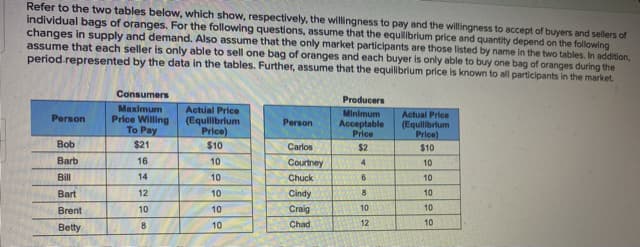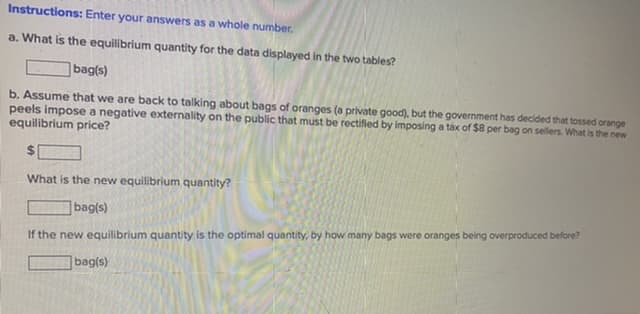a. What is the equilibrium quantity for the data displayed in the two tables? bag(s) b. Assume that we are back to talking about bags of oranges (a private good), but the governmen peels impose a negative externality on the public that must be rectified by imposing a tax of $8 p equilibrium price? %$1 What is the new equilibrium quantity? bag(s) If the new equilibrium quantity is the optimal quantity, by how many bags were oranges being o ]bag(s)
a. What is the equilibrium quantity for the data displayed in the two tables? bag(s) b. Assume that we are back to talking about bags of oranges (a private good), but the governmen peels impose a negative externality on the public that must be rectified by imposing a tax of $8 p equilibrium price? %$1 What is the new equilibrium quantity? bag(s) If the new equilibrium quantity is the optimal quantity, by how many bags were oranges being o ]bag(s)
Chapter18: Asymmetric Information
Section: Chapter Questions
Problem 18.7P
Related questions
Question

Transcribed Image Text:Refer to the two tables below, which show, respectively, the willingness to pay and the willingness to accept of buyers and sellers of
individual bags of oranges. For the following questions, assume that the equilibrium price and quarntity depend on the following
changes in supply and demand. Also assume that the only market participants are those listed by name in the two tables. In addition,
assume that each seller is only able to sell one bag of oranges and each buyer is only able to buy one bag of oranges during the
period represented by the data in the tables. Further, assume that the equilibrium price is known to all participants in the market.
Consumers
Producers
Maximum
Price Willing
To Pay
Actual Price
(Equilibrlum
Price)
Minimum
Actual Price
(Equilibrium
Price)
Person
Person
Acceptable
Price
Bob
$21
$10
Carlos
$2
$10
Barb
16
10
Courtney
4
10
Bill
14
10
Chuck
6
10
Bart
12
10
Cindy
8.
10
Brent
10
10
Craig
10
10
Betty
8
10
Chad
12
10

Transcribed Image Text:Instructions: Enter your answers as a whole number.
a. What is the equilibrium quantity for the data displayed in the two tables?
bag(s)
b. Assume that we are back to talking about bags of oranges (a private good), but the government has decided that tossed orange
peels impose a negative externality on the public that must be rectified by imposing a tax of $8 per bag on sellers. What is the new
equilibrium price?
%24
What is the new equilibrium quantity?
|bag(s)
If the new equilibrium quantity is the optimal quantity, by how many bags were oranges being overproduced before?
bag(s)
Expert Solution
This question has been solved!
Explore an expertly crafted, step-by-step solution for a thorough understanding of key concepts.
This is a popular solution!
Trending now
This is a popular solution!
Step by step
Solved in 3 steps

Recommended textbooks for you


Principles of Microeconomics
Economics
ISBN:
9781305156050
Author:
N. Gregory Mankiw
Publisher:
Cengage Learning


Principles of Microeconomics
Economics
ISBN:
9781305156050
Author:
N. Gregory Mankiw
Publisher:
Cengage Learning